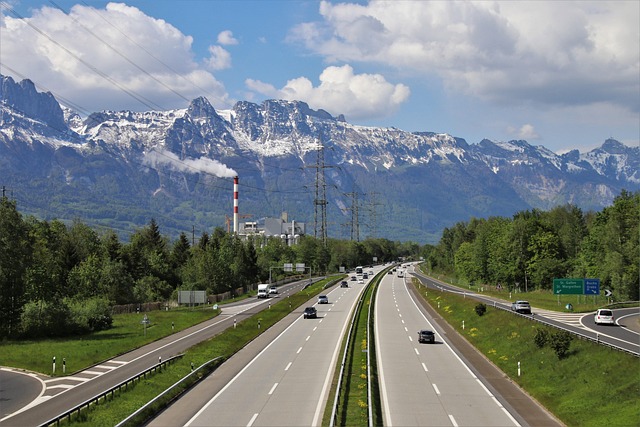Vehicle-to-Vehicle (V2V) communication revolutionizes road safety by sharing real-time vehicle data, enabling drivers to react to potential hazards faster. It integrates with smart grid urban mobility solutions for efficient traffic flow and congestion reduction, optimizing routes. V2V also enhances pedestrian safety through improved road awareness in shared spaces, fostering safer, more efficient transportation networks in bustling cities. However, challenges like cybersecurity and interoperability require public-private partnerships for successful integration into urban planning.
“Revolutionize driver safety with the potential of Vehicle-to-Vehicle (V2V) communication technology. This cutting-edge approach promises to transform the way vehicles interact, enhancing road security and efficiency.
In this article, we explore the fundamentals of V2V tech, uncovering its numerous advantages for drivers. From collision avoidance to real-time traffic updates, we delve into the benefits that could save lives. Furthermore, we examine future prospects and challenges, including privacy concerns and infrastructure requirements, as we navigate towards a safer automotive landscape.”
- Understanding Vehicle-to-Vehicle Communication Technology
- Benefits of V2V Connection for Driver Safety
- Future Implications and Challenges of Advanced V2V Systems
Understanding Vehicle-to-Vehicle Communication Technology

Vehicle-to-Vehicle (V2V) communication technology is revolutionizing road safety by enabling direct communication between cars. This advanced system allows vehicles to share critical data such as position, speed, and brake status in real-time. By leveraging car-to-car communication protocols, V2V technology can detect potential hazards even before drivers are aware of them, providing vital seconds for reaction. For instance, if a vehicle ahead suddenly brakes or encounters an obstacle, nearby cars equipped with this technology can receive the alert and take appropriate action to avoid collisions.
Beyond enhancing vehicular safety, V2V communication integrates seamlessly with smart grid integration urban mobility solutions, contributing to more efficient transportation infrastructure upgrades. It can assist in managing traffic flow, reducing congestion, and optimizing routes based on real-time data. Moreover, pedestrian safety measures benefit from this technology as it improves overall awareness on the road, ensuring not just driver-to-vehicle but also vehicle-to-pedestrian communication for a safer shared space.
Benefits of V2V Connection for Driver Safety

Vehicle-to-Vehicle (V2V) communication is transforming driver safety by enabling vehicles to share data and communicate with each other in real-time. This advanced technology offers numerous benefits, significantly enhancing road safety for all users. By leveraging V2V communication technology, vehicles can exchange critical information such as location, speed, and direction, allowing drivers to make informed decisions and react promptly to potential hazards.
The integration of smart grid technologies into urban mobility solutions further amplifies the advantages of V2V communication. This synergistic approach fosters integrated mobility systems that not only improve driver safety but also optimize traffic flow and reduce congestion. In terms of urban mobility, these innovations contribute to creating more efficient, sustainable, and safer transportation networks, ultimately benefiting folks navigating bustling cities and metropolitan areas.
Future Implications and Challenges of Advanced V2V Systems

The future of advanced driver safety lies heavily on the successful integration and evolution of Vehicle-to-Vehicle (V2V) communication systems. As technology advances, V2V networking has the potential to revolutionize multi-modal transportation networks by enabling vehicles to share real-time data seamlessly. This creates a more informed and predictive driving environment, leading to reduced accidents and improved traffic flow. However, challenges such as ensuring robust security measures against cyber threats, developing standardized protocols for V2V interactions, and integrating these systems into existing public-private partnerships in transport urban planning remain paramount.
Overcoming these hurdles is crucial for the widespread adoption of V2V technology. Public-private collaborations can play a pivotal role in fostering innovation, addressing regulatory frameworks, and ensuring interoperability across different vehicle types and communication standards. As V2V continues to evolve, its integration into smart cities and urban planning will not only enhance road safety but also contribute to more efficient, sustainable, and connected transportation systems.
Vehicle-to-Vehicle (V2V) communication technology holds immense potential to revolutionize road safety by enabling advanced driver assistance systems. By facilitating direct vehicle-to-vehicle and vehicle-to-infrastructure communication, V2V connections can significantly reduce accidents, improve traffic flow, and enhance overall transportation efficiency. As research and development in this field continue, we can expect to see more sophisticated safety features integrated into future vehicles, ultimately leading to safer roads for everyone. The selection and implementation of the right V2V communication standards will be crucial to ensure these systems’ interoperability and effectiveness.
